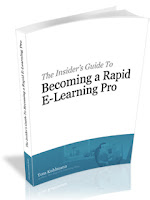10 Tips to Becoming a Rapid E-Learning Pro
I’ve been reading Tom Kuhlmann’s eBook as pictured on the right. Tom is the author of The Rapid E-Learning Blog (part of the Articulate website) and although the book has been around for a wee while, there are some really great ideas and relevant tips in there. I extracted a few of the ones I liked the most for this post:
10 Tips from ‘The Insider’s Guide To Becoming a Rapid E-Learning Pro’:
- The difference between a novice and pro is that the pro knows how to contribute to the organization’s bottom line. Remember, while training is important and e-learning is vital to effective training, the organization’s true goal isn’t to create more training. Instead, the goal is to meet performance objectives. E-learning is just a means to an end, and performance results are the pot of gold at the end of the e-learning rainbow.
- The more relevant the course is to the learners, the more engaged they would be, even if the course isn’t “best in breed” multimedia.
On content authoring tools… - START WITH A TOOL THAT LEVERAGES POWERPOINT. PowerPoint is a very flexible application and most people have access to it, and there are many products that leverage PowerPoint to create Flash-based e-learning.
- The secret is to step away from the PowerPoint look. Treat it like a blank canvas and you can do some really nice things with it.
- Effective e-learning requires assessment, and there are many similar quizzing tools on the market. What I’d look for is SCORM compliance, ability to publish to flash, and ease of use.
- To get the most out of your authoring tool you need to leverage multimedia to make quality e-learning courses.On images, audio and video recording…
- One of the main considerations is whether the image can scale without losing quality. Those that can are called vector images and are preferred when working with most e-learning tools.
- When it comes to audio, start with the best quality you can, because you’ll never have better quality than your source file. [Here are some more tips on recording audio]
- Before you commit to using video, ensure that your organization has the infrastructure and investigate the technology available to your end users.
- Make it a habit never to exceed 3-4 minutes on a single video and you’ll avoid losing viewers.
I would definitely recommend giving the full eBook a read as it’s free to download here.
Photo courtesy of www.articulate.com






